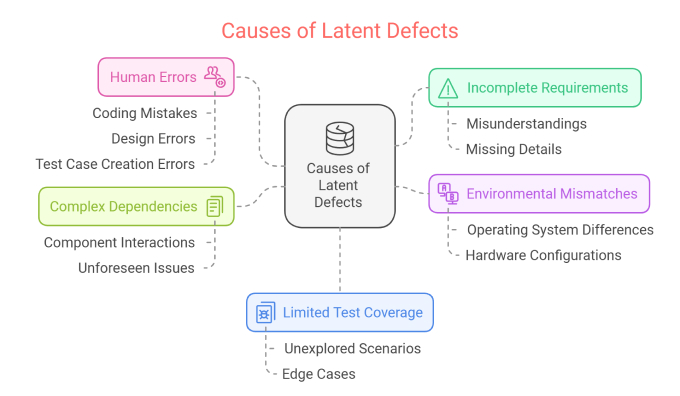Latent Defect
Software defects can appear at any stage of development. Despite all the heavy testing, some flaws remain hidden until particular conditions trigger them. Such defects are called latent defects and are especially dangerous because they often cannot be found during testing. Once the software is put into use, it can lead to unexpected failures, poor performance, and user dissatisfaction.
This article explains latent defects, their causes, and how to identify and resolve them effectively.
What are latent defects?
Latent defects are hidden issues in software that remain undetected during regular testing. They are also known as dormant defects because they stay inactive until specific triggers, such as user actions or environmental changes, occur.
Note: A latent defect is also known as a latent fault or a latent bug, depending on the context
Key points about latent defects:
- They are not identified during standard testing processes.
- They appear when a specific sequence of operations or unusual conditions occurs.
- They can significantly impact functionality, performance, and user experience.
Causes of latent defects
Latent defects can arise from various factors during development. Common causes include:
- Incomplete requirements: Misunderstandings or missing details in requirements documentation can lead to untested edge cases.
- Environmental mismatches: Differences between testing and production environments, such as operating systems or hardware configurations.
- Complex dependencies: Interactions between software components can create unforeseen issues.
- Limited test coverage: Unexplored scenarios or edge cases during testing leave vulnerabilities.
- Human error: Mistakes during coding, design, or test case creation.
- Concurrency issues: Multi-threaded applications often suffer from synchronization problems that appear only under certain conditions.
How to identify latent defects
Latent defects can be hard to spot, but certain strategies help uncover them:
Manual methods
- Exploratory testing: Test unscripted scenarios to reveal unexpected behavior.
- User acceptance testing: (UAT) Engage real users to identify issues in real-world scenarios.
- Error analysis: Study logs and user feedback to find patterns.
Automated methods
- Stress testing: Simulate high workloads to detect issues that arise under pressure.
- Test data variation: Use diverse inputs to identify potential weak points.
- Continuous monitoring: Analyze performance metrics in production for anomalies.
Example of a latent defect
Consider an e-commerce application where users can apply discount coupons. During testing, the team verified that discounts work for products added to the cart. However, after deployment, users reported incorrect discounts when combining coupons with bulk purchases.
- Cause: The defect was latent because the test cases did not include scenarios where multiple discounts were combined.
- Resolution: Adding test cases for coupon combinations resolved the issue.
- Code example: Here’s an example of a unit test to verify discount combinations:
def test_combined_discounts():
cart = ShoppingCart()
cart.add_item("product", price=100)
cart.apply_coupon("DISCOUNT10") # 10% off => 100 - 10 = 90
cart.apply_coupon("BULK5") # Additional 5% off => 90 - 4.5 = 85.5
assert cart.total == 85.5 # Expected result after applying sequential discounts
Latent defects vs. masked defects
Although similar, latent and masked defects manifest differently. For example, latent defects are hidden until a specific condition is triggered, whereas masked defects are hidden by another defect and surface only when the masking defect is resolved.
Monitoring latent defects
Monitoring systems in production helps uncover latent defects early. Key approaches include:
- Use log analysis tools like ELK Stack, Dynatrace, or New Relic to track errors in real time.
- Tracking performance by monitoring response times, CPU usage, and memory.
- Set alerts to detect abnormal behavior quickly.
- Follow chaos engineering practices, such as fault injection, using tools like Gremlin or Chaos Monkey to simulate failures in production-like environments.
How to prevent latent defects
Preventing latent defects requires proactive measures:
- Thorough testing: Design test cases to cover edge scenarios and boundary conditions.
- Simulate production environments: Match testing conditions with real-world environments as closely as possible.
- Code reviews: Regularly review code for potential flaws or gaps.
- Use test automation: Automate regression tests to ensure updates don’t introduce new issues.
Conclusion
Although latent defects are challenging to detect, it is critical to address them to improve the application’s reliability. By implementing robust testing strategies, leveraging automation, and monitoring real-world performance, teams can reduce the risks posed by these hidden issues. Regular testing and proactive measures ensure software performs as expected under all conditions.



